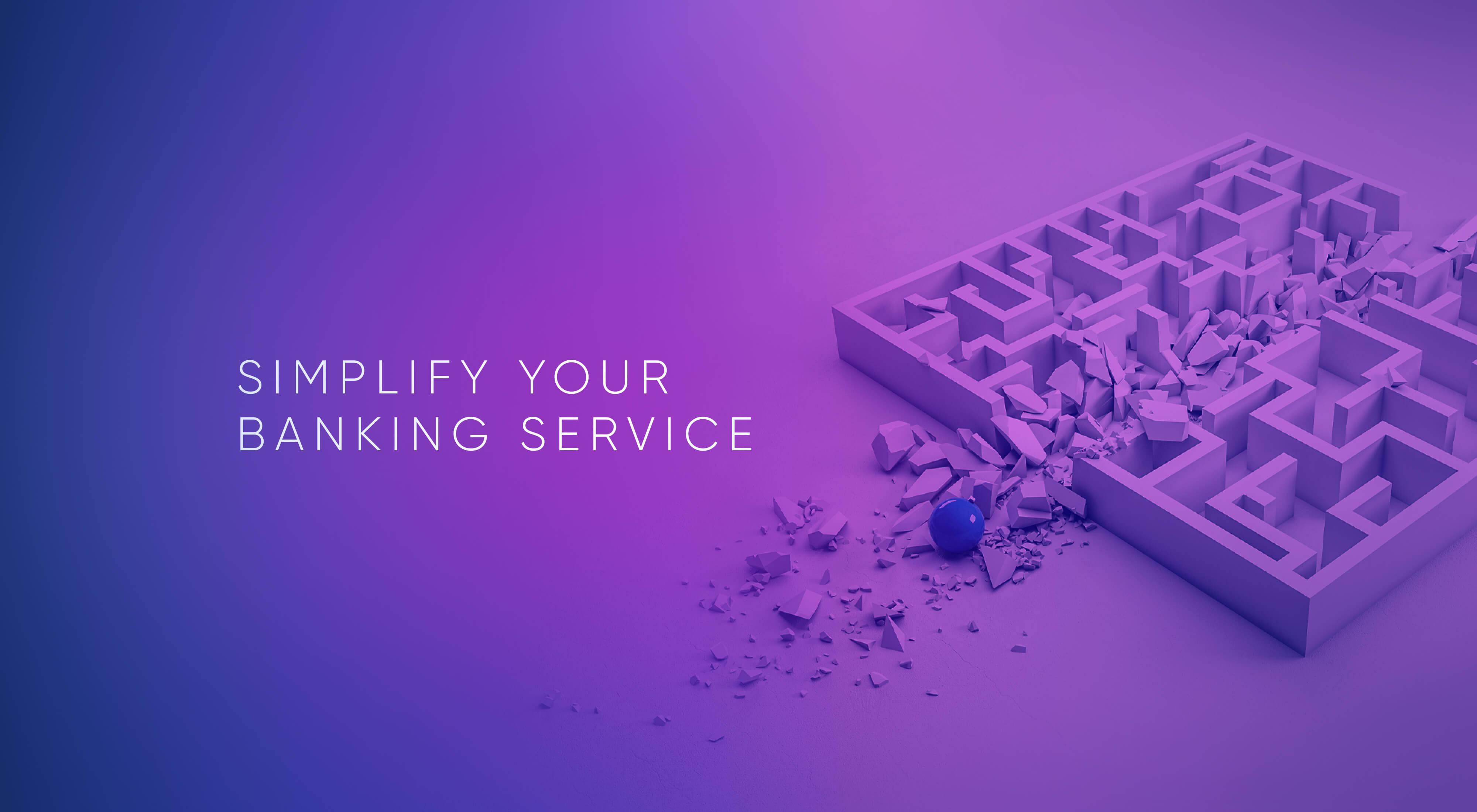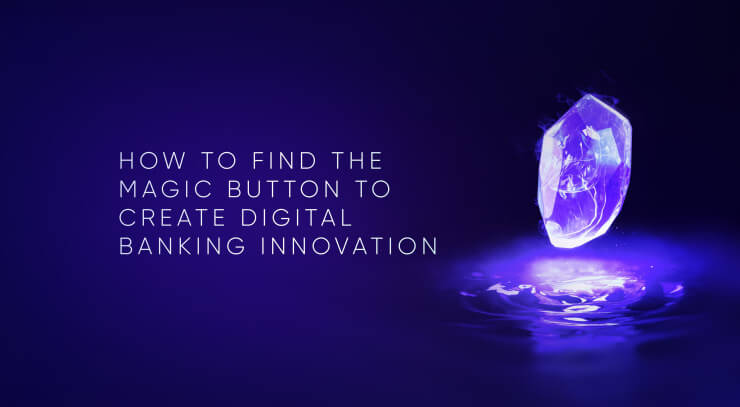Each year technology makes the world more complex for people to understand. So, easy-to-use services for consumers are in particularly great demand. Due to the nature of the human mind: it is vital to perceive the world in a simple way. Any financial service can get an advantage by delivering a perfect user experience based on a simple interface.
Simplicity starts revolutions
First things first: let's keep in mind that this article is about simplicity as a whole mindset. This world perception model is based on human-centered design thinking. It is focused on making the best solutions to meet the users’ needs, while taking into account uniqueness of their perception and behavioral patterns.
Sometimes this approach for digital financial products may be considered as revolutionary. It’s been a long time since users had an alternative to traditional financial services, and banks simply got used to it. If there is demand for specific financial service bank can develop it anyway they want it and there will be demand for that.
Such way of digital service development provoked the emergence of Fintech startups and different financial industry innovations. This led to the financial industry disruption.
Why simplicity? Let's take the Chanel's little black dress, Malevich’s square, or the first iPhone as examples. What unites them and what came before them? For instance, before Chanel, the fashion industry was overwhelmed with women's dresses with lots of frills and jewelry. The little, black dress manifested simplicity, yet versatility.
The same breakthrough was The Black Square, challenging classical painting and impressionism. Malevich proved that simple shapes also have beauty and artistic value. This broke the perception and creativity patterns of the art industry.
Approximately 90 years later, in 2007, Steve Jobs made complex and limited button mobile phones a relic of the past and turned the phone into a new device, which had calls as a secondary option. In just 10 years, his new direction of technological development has completely changed our way of life and the values of people around the world. It also boosted the disruption of many industries.
These examples show that the revolution began as a way to make some difficult, inconvenient, but habitual things simple. Nowadays, the same process may be observed in the financial services sector.
At the same time, it is very important not to confuse simplification with primitivism. The simplification of the car with mechanical transmission is a transition to automatic transmission, which greatly facilitates control. Primitivism would be the transition from a car to a motorcycle or to even a bike. Of course, this can simplify the control, but the key user functions making the real vehicle value are gone.
The appropriate simplification allows a user to achieve the same, or an even greater result, but with less effort and less knowledge. Often, simplification requires hard work and a complex system on a background to relieve user journey. So, if we go even further into the idea of car simplification, we will see a self driving car with no human involved in the driving.
The brain loves simplicity
The simplicity value is determined by the human brain’s peculiarities. Every concept in the human brain forms neuron connections. So, simpler concepts require fewer neuron links and fewer repetitions.
As far as evolution is concerned, our survival has always depended on reactions and the speed of processing information. Therefore, the brain favors to form simple links. This can be seen in children. They learn simple things much faster: for instance, food and surroundings. But abstract concepts like mathematics, tasks, or information processing are more difficult for them.
This means that simple interfaces are mastered and memorized more easily because neural links are formed here easier and faster. Especially, if the user is already familiar with the principles and elements used in the interface. It means that the proper neural links are already formed, and it is easier to add new ones related to the new service.
Conversely, if a user comes across a completely new interface operating on unknown principles, it will take a great deal of time to form a new neural link. Especially, if there are too many interface elements or if they are unstructured. This can cause choice paralysis syndrome and dramatically decrease user satisfaction levels.
What are the key principles of simple banking
As we see, simplicity provides our brain with the background for evolutionary survival. Therefore, it is programmed into the system of our perception and interaction with the world. By understanding simplicity, it’s possible to highlight the key principles of simple banking.
1. Predictability
In its interaction with the world, the brain simplifies the perception of things to predict the interaction result and provide safety. It means that the solution offered to users should be predictable. Answers to the questions on how and where should be obvious.
2. Control
It is important for a user to have a sense of control over the situation as it gives confidence. If there are too many elements not allowing to quickly build a clear mental model - panic strikes. Control reduces the risk of error and the cognitive pressure, which is especially important from financial perspective. It coordinates the service functions and the desired result.
3. Ease
People generally act based on the principle of least resistance, i.e. they do what is easier and choose what is clearer. So, a good financial interface should be very simple, providing a user with a smooth and obvious user flows. It increases speed and user satisfaction.
What are the levels of financial services simplification
It is necessary to use a general-to-specific approach in the creation of service as a complete system. The most important thing here is to maintain a high level of empathy towards the user, thus making the processes human-centered. Design Thinking and UX design should come in handy here.
Our aim is to reduce the user's cognitive load. To do this, we are going top-down when arranging simplicity levels in the interface design. First, we define the perception elements to create a user’s mental model. After goes the implementation of a user’s scenarios into the interface. It determines user interactions and user flows through the elements of design and the service functions.
1. Make information architecture clear
When interacting with any digital service the user builds a mental map in his mind. This map should answer how to implement a particular scenario, where to look for information, and what opportunities the service provides. The basis here, is the navigation and the information blocks of the service.
It is necessary to base information architecture on a user’s existing cognitive patterns to make it clear and predictable. The Card Sorting identification method really comes in handy here. All the elements and the service functions should be logically grouped for a user based on his cognitive patterns. Moreover, there shouldn’t be too many basic sections in navigation, so that the user can get an idea of the service structure at a quick glance.
2. Create friendly content
Speak the user’s language, and avoid professional slang in the interface. This will make your interface clear, regardless of the user's level of knowledge. Use clear words, short phrases, and minimum text.
In 2005, Oppenheimer conducted a study on the complexity of text as a means to form an opinion about its author. He found that the more complex the text was, the lower his intelligence level was rated by readers.
3. Design delightful interface
The human desire for beauty is conditioned by evolution. Our ancestors associated bright colors to detect ripe fruits and berries. The choice of an attractive partner provided a healthy offspring. A beautiful surrounding made it possible to choose safe accommodation.
Aesthetic pleasure has become a distinctive feature of humanity and the cornerstone of our culture. Therefore, the UX equals aesthetic value. Outdated and primitive design will not cause pleasant emotions and will therefore reduce the service value for the user.
This fact has been proven by much research. For example, the concept of aesthetics contributes to the success of companies and brands (Rompay & Pruyn, 2011). In terms of strategic pricing, it enables companies to gain higher profits by letting them determine higher prices (Kristensen et al. 2012).
4. Ensure safe interactions
Provide a clear and predictable operation of the separate individual interface elements. Rely on existing custom patterns to speed up and facilitate the use of the service. Don’t forget that each element should respond to a user’s actions, giving him enough feedback.
5. Provide gradual delivery of functions
All the screens and micro-actions should be arranged in an obvious and intuitive sequence, corresponding to the key scenarios. In addition, they should be implemented gradually and consistently. Do not give the user everything at single dashboard, as it may cause cognitive overload.
How to make digital banking and finance simple
So, let's find out exactly how financial services can simplify interfaces and make them clear for users.
Step 1. Reduce overdensity
Overdensity is the worst enemy of your design. Too many elements will frustrate the user and ruin his experience. Fill the service real estate wisely providing enough "white space". Clear indents will separate elements from each other and make the interface more readable.
Overdensity concerns not only the number of elements, but also the diversity of their visual characteristics. The overcharge with multi-colors and multi-shapes will definitely create a sense of chaos. Stick to coherent and holistic aesthetics forming easy to understand design language.
Step 2. Divide the tasks into steps
When a digital service requires some action from the user it is better to divide it into step-by-step tasks instead of taking it all into one screen. You can use progressive disclosure in your forms or divide processes onto several screens by using layers behind primary pages. This should help to manage user attention and keep flow clear.
Step 3. Get familiar
Both desktop solutions and mobile applications have already developed standards for interface solutions. They are related to user habits and accelerate the learning curve. For instance, users expect to see a profile or login in the upper left corner. The search bar in the mobile solutions should be at the top of the list.
This rule applies not only to the individual elements and their location, but also to the entire pages or functions. Ignoring usage patterns and creating something completely unusual can lead to extending the learning curve, and often to a failure.
Step 4. Balance critical touchpoints
Explore the user’s journey through your service and detect key touchpoints that can frustrate him. Find some better solutions.
For instance, you can simplify the UI, rearrange the flow, and make micro-interactions more obvious, or just add some handy tips. You can do anything, just don't leave the user alone in difficult moments.
Step 5. Ensure correct accents
All the interface elements may be located according to their priority for the user experience. It’s necessary to consider their role in the user tasks execution. So, you can determine their priority in every screen.
Use different visual means for accents: font size, color, shape, icon. This will help the user to follow the sequence and interface logic intuitively.
The same thing is true for the element grouping. Proper interface space zoning will help to group the elements according to the key user scenarios.
Step 6. Adopt consistent design language
The user should not have a feeling of diversity when using the service. Its flow should be smooth and connected. It’s essential to see the design as a system to ensure this.
The system of design standardizes the principles of interface creation, regulates the UI of the elements used and introduces consistency rules. On the one hand, the system design should respect the particular digital platform guidelines, but on the other, create a native look and feeling uniting the service supply on all platforms.
Step 7. Implement accessibility requirements
Around 4% of all people have some visual problems. It's really important to ensure banking interface accessibility for them through the right use of contrast, color, and font size.
For example, in case of an error you should avoid using color as the only element to indicate the required action. It is better to combine it with an icon and a notification.
Other possible limitations should also be considered. For example, it’s simply impossible to use interfaces overloaded by animation in regions with low Internet speed.
Don’t be afraid of simplicity
Other people’s opinions are important for everyone, it’s human nature. What will be said about the abilities, the knowledge level, and the intelligence of the creator through his work? Therefore, complex solutions often appear in the interfaces design to impress the user, strike him, and provide maximum opportunities for him. But such solutions are incomprehensible and inconvenient as it was discussed in this article, so they are not in demand. Thus, don't be afraid of simplicity.
Smart designers are willing to create the simplest interfaces responding to the complex needs of the user.
In this article we explored that it’s not a simple appearance or a primitive functionality, that makes simplicity. And simplicity is not the key goal of a good design. Simplicity is just a tool to provide a user with a handy and delightful experience. Powerful and complex tool.
Get UXDA Research-Based White Paper "How to Win the Hearts of Digital Customers":
 If you want to create next-gen financial products to receive an exceptional competitive advantage in the digital age, contact us! With the power of financial UX design, we can help you turn your business into a beloved financial brand with a strong emotional connection with your clients, resulting in success, demand, and long-term customer loyalty.
If you want to create next-gen financial products to receive an exceptional competitive advantage in the digital age, contact us! With the power of financial UX design, we can help you turn your business into a beloved financial brand with a strong emotional connection with your clients, resulting in success, demand, and long-term customer loyalty.
- E-mail us at info@theuxda.com
- Chat with us in Whatsapp
- Send a direct message to UXDA's CEO Alex Kreger on Linkedin




















